Case Study: Roles, Dilemmas, and Sustainability in Organizations
VerifiedAdded on 2023/06/05
|11
|2800
|130
Case Study
AI Summary
This case study analyzes the roles and responsibilities of Christoph Gebald and Jan Wurzbacher as sustainable strategic managers in their venture, focusing on their efforts to capture carbon dioxide from the atmosphere. It examines the concepts and tools of strategic business management, such as the Objectives and Key Results (OKR) framework and the Triple Bottom Line, applicable to sustainability issues. The analysis explores the formulation of strategies, promoting employee health and safety, and raising awareness. Furthermore, the case study discusses the economic and ethical dilemmas faced by strategic leaders in balancing short and long-term goals, including cash flow management, globalization versus regionalism, honesty, and ensuring justice within the organization. The conclusion emphasizes the importance of considering environmental factors and implementing sustainable measures for organizational success.

Paraphrase This Document
Need a fresh take? Get an instant paraphrase of this document with our AI Paraphraser
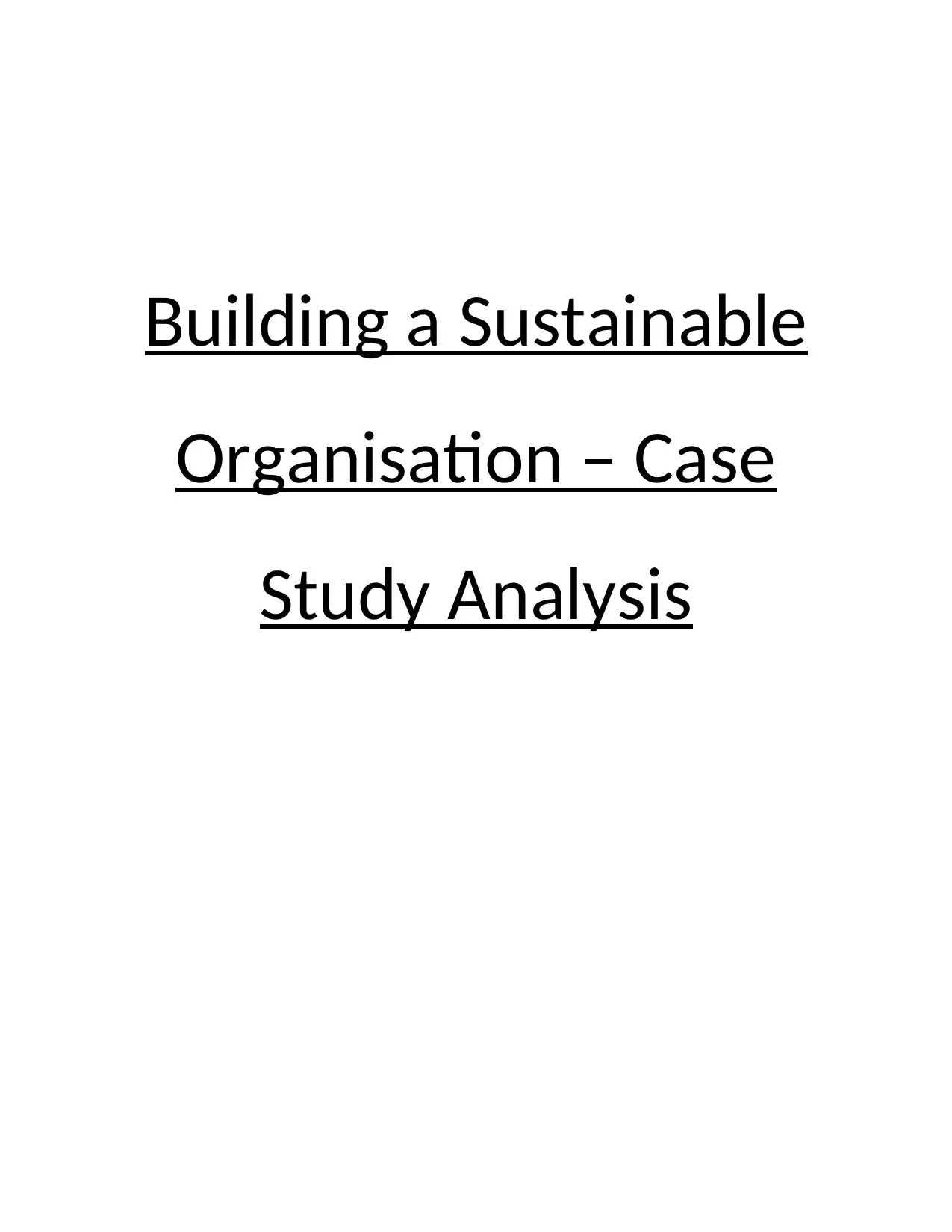
Building a Sustainable
Organisation – Case
Study Analysis
Organisation – Case
Study Analysis
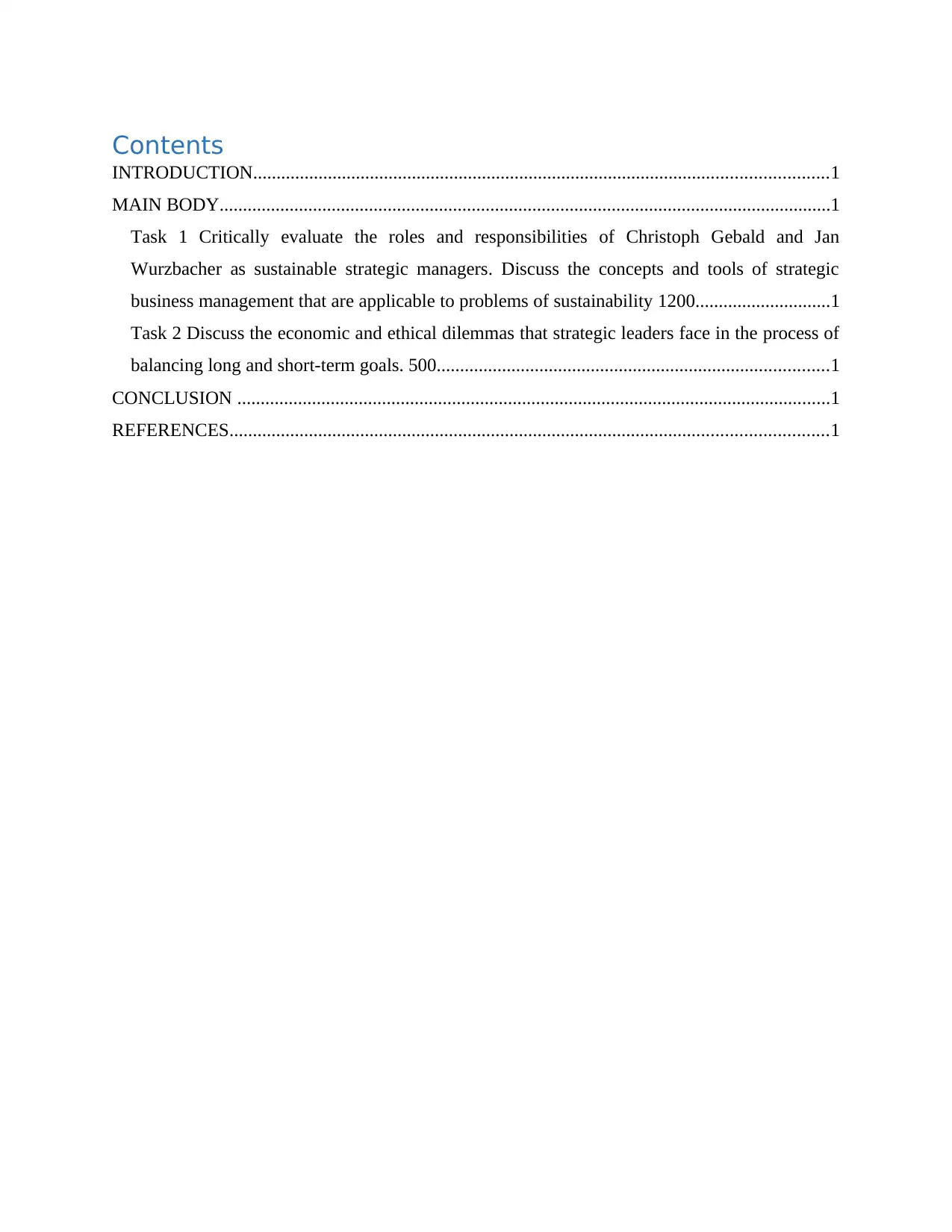
Contents
INTRODUCTION...........................................................................................................................1
MAIN BODY...................................................................................................................................1
Task 1 Critically evaluate the roles and responsibilities of Christoph Gebald and Jan
Wurzbacher as sustainable strategic managers. Discuss the concepts and tools of strategic
business management that are applicable to problems of sustainability 1200.............................1
Task 2 Discuss the economic and ethical dilemmas that strategic leaders face in the process of
balancing long and short-term goals. 500....................................................................................1
CONCLUSION ...............................................................................................................................1
REFERENCES................................................................................................................................1
INTRODUCTION...........................................................................................................................1
MAIN BODY...................................................................................................................................1
Task 1 Critically evaluate the roles and responsibilities of Christoph Gebald and Jan
Wurzbacher as sustainable strategic managers. Discuss the concepts and tools of strategic
business management that are applicable to problems of sustainability 1200.............................1
Task 2 Discuss the economic and ethical dilemmas that strategic leaders face in the process of
balancing long and short-term goals. 500....................................................................................1
CONCLUSION ...............................................................................................................................1
REFERENCES................................................................................................................................1
⊘ This is a preview!⊘
Do you want full access?
Subscribe today to unlock all pages.

Trusted by 1+ million students worldwide

Paraphrase This Document
Need a fresh take? Get an instant paraphrase of this document with our AI Paraphraser
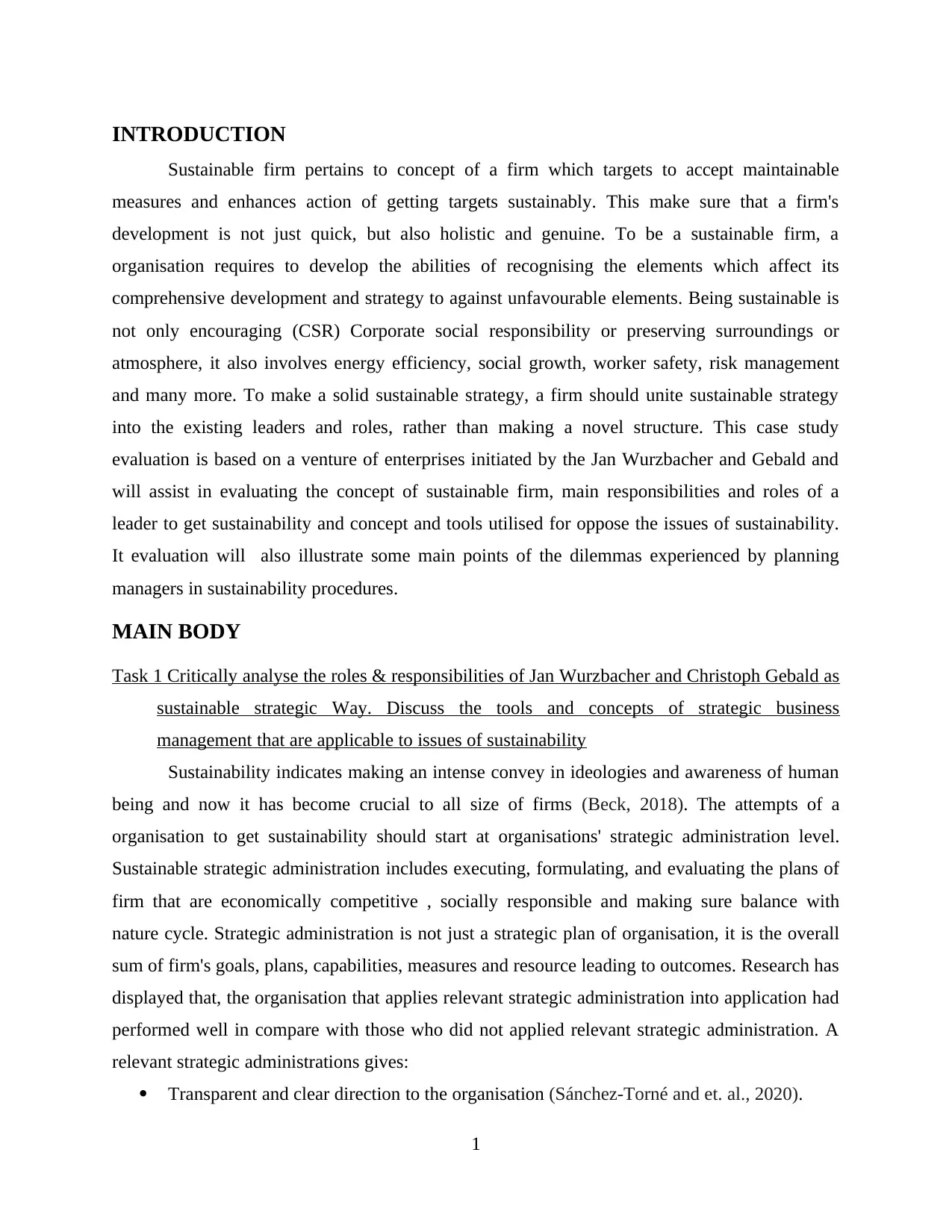
INTRODUCTION
Sustainable firm pertains to concept of a firm which targets to accept maintainable
measures and enhances action of getting targets sustainably. This make sure that a firm's
development is not just quick, but also holistic and genuine. To be a sustainable firm, a
organisation requires to develop the abilities of recognising the elements which affect its
comprehensive development and strategy to against unfavourable elements. Being sustainable is
not only encouraging (CSR) Corporate social responsibility or preserving surroundings or
atmosphere, it also involves energy efficiency, social growth, worker safety, risk management
and many more. To make a solid sustainable strategy, a firm should unite sustainable strategy
into the existing leaders and roles, rather than making a novel structure. This case study
evaluation is based on a venture of enterprises initiated by the Jan Wurzbacher and Gebald and
will assist in evaluating the concept of sustainable firm, main responsibilities and roles of a
leader to get sustainability and concept and tools utilised for oppose the issues of sustainability.
It evaluation will also illustrate some main points of the dilemmas experienced by planning
managers in sustainability procedures.
MAIN BODY
Task 1 Critically analyse the roles & responsibilities of Jan Wurzbacher and Christoph Gebald as
sustainable strategic Way. Discuss the tools and concepts of strategic business
management that are applicable to issues of sustainability
Sustainability indicates making an intense convey in ideologies and awareness of human
being and now it has become crucial to all size of firms (Beck, 2018). The attempts of a
organisation to get sustainability should start at organisations' strategic administration level.
Sustainable strategic administration includes executing, formulating, and evaluating the plans of
firm that are economically competitive , socially responsible and making sure balance with
nature cycle. Strategic administration is not just a strategic plan of organisation, it is the overall
sum of firm's goals, plans, capabilities, measures and resource leading to outcomes. Research has
displayed that, the organisation that applies relevant strategic administration into application had
performed well in compare with those who did not applied relevant strategic administration. A
relevant strategic administrations gives:
Transparent and clear direction to the organisation (Sánchez‐Torné and et. al., 2020).
1
Sustainable firm pertains to concept of a firm which targets to accept maintainable
measures and enhances action of getting targets sustainably. This make sure that a firm's
development is not just quick, but also holistic and genuine. To be a sustainable firm, a
organisation requires to develop the abilities of recognising the elements which affect its
comprehensive development and strategy to against unfavourable elements. Being sustainable is
not only encouraging (CSR) Corporate social responsibility or preserving surroundings or
atmosphere, it also involves energy efficiency, social growth, worker safety, risk management
and many more. To make a solid sustainable strategy, a firm should unite sustainable strategy
into the existing leaders and roles, rather than making a novel structure. This case study
evaluation is based on a venture of enterprises initiated by the Jan Wurzbacher and Gebald and
will assist in evaluating the concept of sustainable firm, main responsibilities and roles of a
leader to get sustainability and concept and tools utilised for oppose the issues of sustainability.
It evaluation will also illustrate some main points of the dilemmas experienced by planning
managers in sustainability procedures.
MAIN BODY
Task 1 Critically analyse the roles & responsibilities of Jan Wurzbacher and Christoph Gebald as
sustainable strategic Way. Discuss the tools and concepts of strategic business
management that are applicable to issues of sustainability
Sustainability indicates making an intense convey in ideologies and awareness of human
being and now it has become crucial to all size of firms (Beck, 2018). The attempts of a
organisation to get sustainability should start at organisations' strategic administration level.
Sustainable strategic administration includes executing, formulating, and evaluating the plans of
firm that are economically competitive , socially responsible and making sure balance with
nature cycle. Strategic administration is not just a strategic plan of organisation, it is the overall
sum of firm's goals, plans, capabilities, measures and resource leading to outcomes. Research has
displayed that, the organisation that applies relevant strategic administration into application had
performed well in compare with those who did not applied relevant strategic administration. A
relevant strategic administrations gives:
Transparent and clear direction to the organisation (Sánchez‐Torné and et. al., 2020).
1
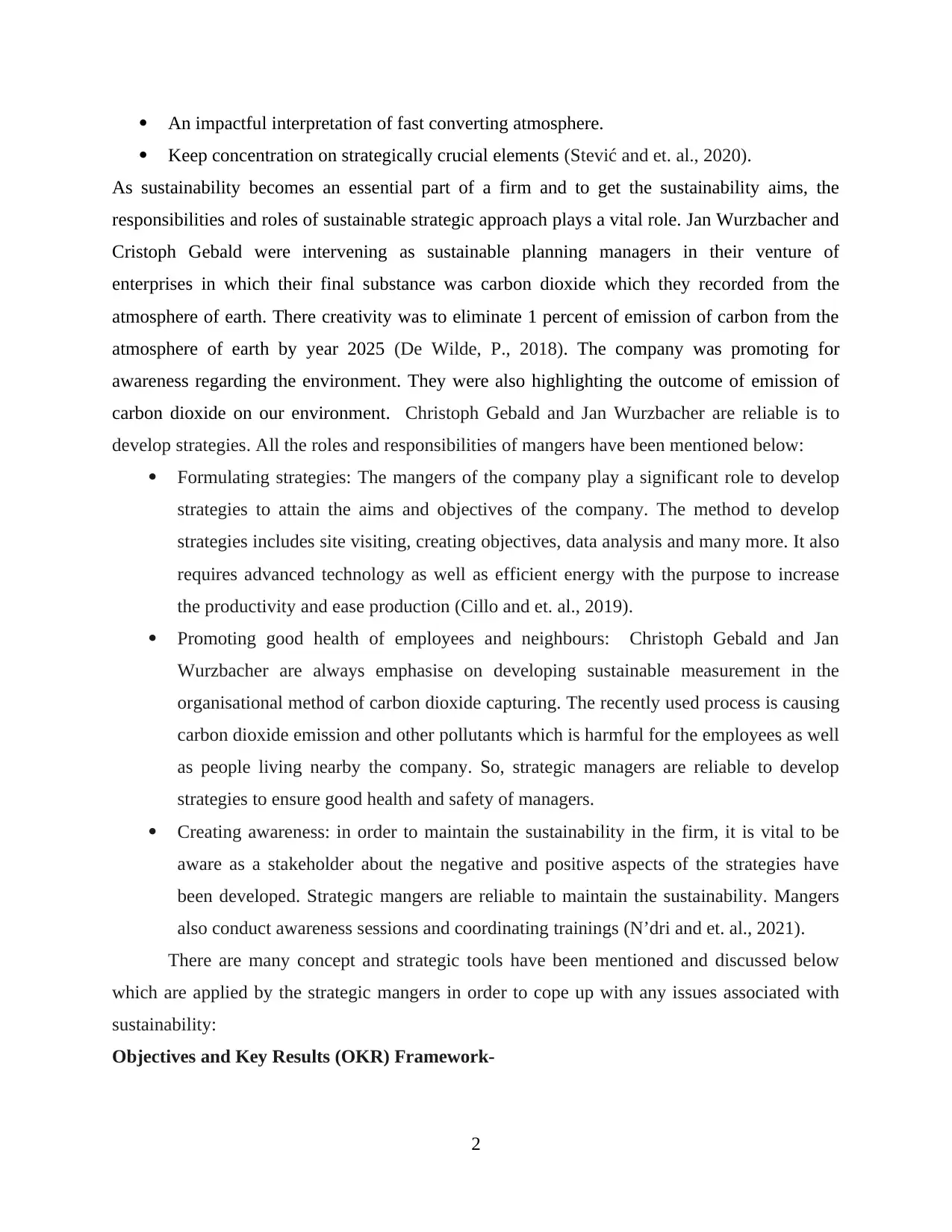
An impactful interpretation of fast converting atmosphere.
Keep concentration on strategically crucial elements (Stević and et. al., 2020).
As sustainability becomes an essential part of a firm and to get the sustainability aims, the
responsibilities and roles of sustainable strategic approach plays a vital role. Jan Wurzbacher and
Cristoph Gebald were intervening as sustainable planning managers in their venture of
enterprises in which their final substance was carbon dioxide which they recorded from the
atmosphere of earth. There creativity was to eliminate 1 percent of emission of carbon from the
atmosphere of earth by year 2025 (De Wilde, P., 2018). The company was promoting for
awareness regarding the environment. They were also highlighting the outcome of emission of
carbon dioxide on our environment. Christoph Gebald and Jan Wurzbacher are reliable is to
develop strategies. All the roles and responsibilities of mangers have been mentioned below:
Formulating strategies: The mangers of the company play a significant role to develop
strategies to attain the aims and objectives of the company. The method to develop
strategies includes site visiting, creating objectives, data analysis and many more. It also
requires advanced technology as well as efficient energy with the purpose to increase
the productivity and ease production (Cillo and et. al., 2019).
Promoting good health of employees and neighbours: Christoph Gebald and Jan
Wurzbacher are always emphasise on developing sustainable measurement in the
organisational method of carbon dioxide capturing. The recently used process is causing
carbon dioxide emission and other pollutants which is harmful for the employees as well
as people living nearby the company. So, strategic managers are reliable to develop
strategies to ensure good health and safety of managers.
Creating awareness: in order to maintain the sustainability in the firm, it is vital to be
aware as a stakeholder about the negative and positive aspects of the strategies have
been developed. Strategic mangers are reliable to maintain the sustainability. Mangers
also conduct awareness sessions and coordinating trainings (N’dri and et. al., 2021).
There are many concept and strategic tools have been mentioned and discussed below
which are applied by the strategic mangers in order to cope up with any issues associated with
sustainability:
Objectives and Key Results (OKR) Framework-
2
Keep concentration on strategically crucial elements (Stević and et. al., 2020).
As sustainability becomes an essential part of a firm and to get the sustainability aims, the
responsibilities and roles of sustainable strategic approach plays a vital role. Jan Wurzbacher and
Cristoph Gebald were intervening as sustainable planning managers in their venture of
enterprises in which their final substance was carbon dioxide which they recorded from the
atmosphere of earth. There creativity was to eliminate 1 percent of emission of carbon from the
atmosphere of earth by year 2025 (De Wilde, P., 2018). The company was promoting for
awareness regarding the environment. They were also highlighting the outcome of emission of
carbon dioxide on our environment. Christoph Gebald and Jan Wurzbacher are reliable is to
develop strategies. All the roles and responsibilities of mangers have been mentioned below:
Formulating strategies: The mangers of the company play a significant role to develop
strategies to attain the aims and objectives of the company. The method to develop
strategies includes site visiting, creating objectives, data analysis and many more. It also
requires advanced technology as well as efficient energy with the purpose to increase
the productivity and ease production (Cillo and et. al., 2019).
Promoting good health of employees and neighbours: Christoph Gebald and Jan
Wurzbacher are always emphasise on developing sustainable measurement in the
organisational method of carbon dioxide capturing. The recently used process is causing
carbon dioxide emission and other pollutants which is harmful for the employees as well
as people living nearby the company. So, strategic managers are reliable to develop
strategies to ensure good health and safety of managers.
Creating awareness: in order to maintain the sustainability in the firm, it is vital to be
aware as a stakeholder about the negative and positive aspects of the strategies have
been developed. Strategic mangers are reliable to maintain the sustainability. Mangers
also conduct awareness sessions and coordinating trainings (N’dri and et. al., 2021).
There are many concept and strategic tools have been mentioned and discussed below
which are applied by the strategic mangers in order to cope up with any issues associated with
sustainability:
Objectives and Key Results (OKR) Framework-
2
⊘ This is a preview!⊘
Do you want full access?
Subscribe today to unlock all pages.

Trusted by 1+ million students worldwide
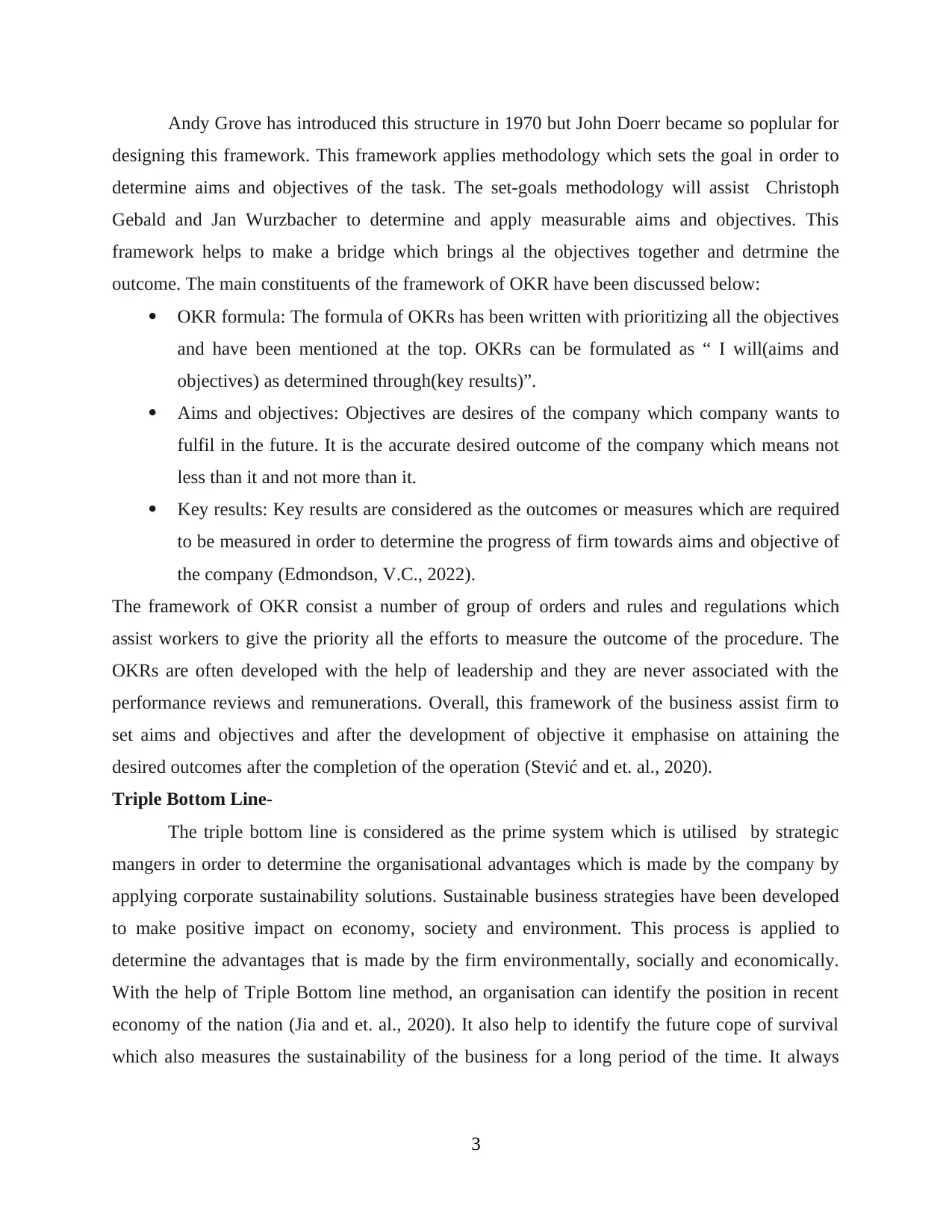
Andy Grove has introduced this structure in 1970 but John Doerr became so poplular for
designing this framework. This framework applies methodology which sets the goal in order to
determine aims and objectives of the task. The set-goals methodology will assist Christoph
Gebald and Jan Wurzbacher to determine and apply measurable aims and objectives. This
framework helps to make a bridge which brings al the objectives together and detrmine the
outcome. The main constituents of the framework of OKR have been discussed below:
OKR formula: The formula of OKRs has been written with prioritizing all the objectives
and have been mentioned at the top. OKRs can be formulated as “ I will(aims and
objectives) as determined through(key results)”.
Aims and objectives: Objectives are desires of the company which company wants to
fulfil in the future. It is the accurate desired outcome of the company which means not
less than it and not more than it.
Key results: Key results are considered as the outcomes or measures which are required
to be measured in order to determine the progress of firm towards aims and objective of
the company (Edmondson, V.C., 2022).
The framework of OKR consist a number of group of orders and rules and regulations which
assist workers to give the priority all the efforts to measure the outcome of the procedure. The
OKRs are often developed with the help of leadership and they are never associated with the
performance reviews and remunerations. Overall, this framework of the business assist firm to
set aims and objectives and after the development of objective it emphasise on attaining the
desired outcomes after the completion of the operation (Stević and et. al., 2020).
Triple Bottom Line-
The triple bottom line is considered as the prime system which is utilised by strategic
mangers in order to determine the organisational advantages which is made by the company by
applying corporate sustainability solutions. Sustainable business strategies have been developed
to make positive impact on economy, society and environment. This process is applied to
determine the advantages that is made by the firm environmentally, socially and economically.
With the help of Triple Bottom line method, an organisation can identify the position in recent
economy of the nation (Jia and et. al., 2020). It also help to identify the future cope of survival
which also measures the sustainability of the business for a long period of the time. It always
3
designing this framework. This framework applies methodology which sets the goal in order to
determine aims and objectives of the task. The set-goals methodology will assist Christoph
Gebald and Jan Wurzbacher to determine and apply measurable aims and objectives. This
framework helps to make a bridge which brings al the objectives together and detrmine the
outcome. The main constituents of the framework of OKR have been discussed below:
OKR formula: The formula of OKRs has been written with prioritizing all the objectives
and have been mentioned at the top. OKRs can be formulated as “ I will(aims and
objectives) as determined through(key results)”.
Aims and objectives: Objectives are desires of the company which company wants to
fulfil in the future. It is the accurate desired outcome of the company which means not
less than it and not more than it.
Key results: Key results are considered as the outcomes or measures which are required
to be measured in order to determine the progress of firm towards aims and objective of
the company (Edmondson, V.C., 2022).
The framework of OKR consist a number of group of orders and rules and regulations which
assist workers to give the priority all the efforts to measure the outcome of the procedure. The
OKRs are often developed with the help of leadership and they are never associated with the
performance reviews and remunerations. Overall, this framework of the business assist firm to
set aims and objectives and after the development of objective it emphasise on attaining the
desired outcomes after the completion of the operation (Stević and et. al., 2020).
Triple Bottom Line-
The triple bottom line is considered as the prime system which is utilised by strategic
mangers in order to determine the organisational advantages which is made by the company by
applying corporate sustainability solutions. Sustainable business strategies have been developed
to make positive impact on economy, society and environment. This process is applied to
determine the advantages that is made by the firm environmentally, socially and economically.
With the help of Triple Bottom line method, an organisation can identify the position in recent
economy of the nation (Jia and et. al., 2020). It also help to identify the future cope of survival
which also measures the sustainability of the business for a long period of the time. It always
3
Paraphrase This Document
Need a fresh take? Get an instant paraphrase of this document with our AI Paraphraser
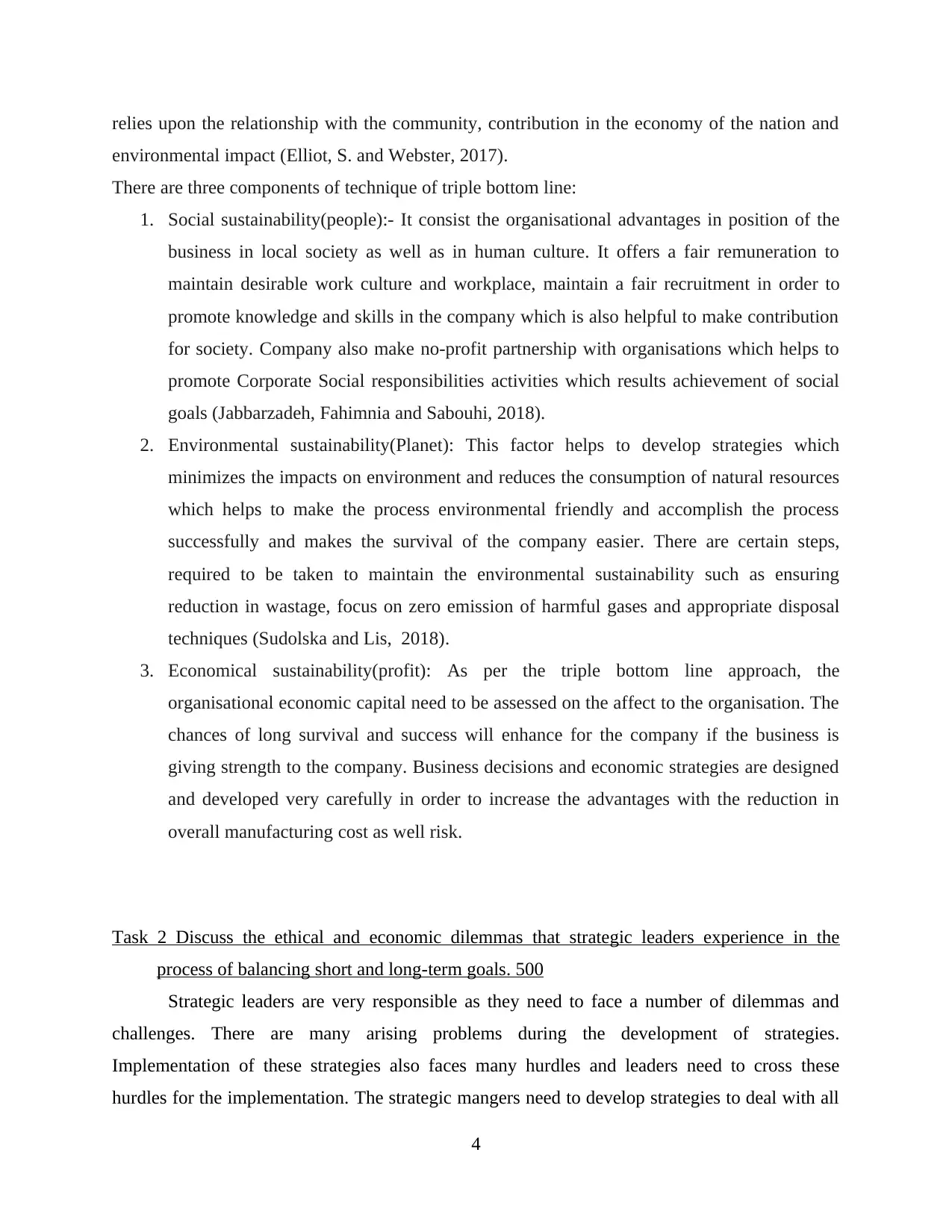
relies upon the relationship with the community, contribution in the economy of the nation and
environmental impact (Elliot, S. and Webster, 2017).
There are three components of technique of triple bottom line:
1. Social sustainability(people):- It consist the organisational advantages in position of the
business in local society as well as in human culture. It offers a fair remuneration to
maintain desirable work culture and workplace, maintain a fair recruitment in order to
promote knowledge and skills in the company which is also helpful to make contribution
for society. Company also make no-profit partnership with organisations which helps to
promote Corporate Social responsibilities activities which results achievement of social
goals (Jabbarzadeh, Fahimnia and Sabouhi, 2018).
2. Environmental sustainability(Planet): This factor helps to develop strategies which
minimizes the impacts on environment and reduces the consumption of natural resources
which helps to make the process environmental friendly and accomplish the process
successfully and makes the survival of the company easier. There are certain steps,
required to be taken to maintain the environmental sustainability such as ensuring
reduction in wastage, focus on zero emission of harmful gases and appropriate disposal
techniques (Sudolska and Lis, 2018).
3. Economical sustainability(profit): As per the triple bottom line approach, the
organisational economic capital need to be assessed on the affect to the organisation. The
chances of long survival and success will enhance for the company if the business is
giving strength to the company. Business decisions and economic strategies are designed
and developed very carefully in order to increase the advantages with the reduction in
overall manufacturing cost as well risk.
Task 2 Discuss the ethical and economic dilemmas that strategic leaders experience in the
process of balancing short and long-term goals. 500
Strategic leaders are very responsible as they need to face a number of dilemmas and
challenges. There are many arising problems during the development of strategies.
Implementation of these strategies also faces many hurdles and leaders need to cross these
hurdles for the implementation. The strategic mangers need to develop strategies to deal with all
4
environmental impact (Elliot, S. and Webster, 2017).
There are three components of technique of triple bottom line:
1. Social sustainability(people):- It consist the organisational advantages in position of the
business in local society as well as in human culture. It offers a fair remuneration to
maintain desirable work culture and workplace, maintain a fair recruitment in order to
promote knowledge and skills in the company which is also helpful to make contribution
for society. Company also make no-profit partnership with organisations which helps to
promote Corporate Social responsibilities activities which results achievement of social
goals (Jabbarzadeh, Fahimnia and Sabouhi, 2018).
2. Environmental sustainability(Planet): This factor helps to develop strategies which
minimizes the impacts on environment and reduces the consumption of natural resources
which helps to make the process environmental friendly and accomplish the process
successfully and makes the survival of the company easier. There are certain steps,
required to be taken to maintain the environmental sustainability such as ensuring
reduction in wastage, focus on zero emission of harmful gases and appropriate disposal
techniques (Sudolska and Lis, 2018).
3. Economical sustainability(profit): As per the triple bottom line approach, the
organisational economic capital need to be assessed on the affect to the organisation. The
chances of long survival and success will enhance for the company if the business is
giving strength to the company. Business decisions and economic strategies are designed
and developed very carefully in order to increase the advantages with the reduction in
overall manufacturing cost as well risk.
Task 2 Discuss the ethical and economic dilemmas that strategic leaders experience in the
process of balancing short and long-term goals. 500
Strategic leaders are very responsible as they need to face a number of dilemmas and
challenges. There are many arising problems during the development of strategies.
Implementation of these strategies also faces many hurdles and leaders need to cross these
hurdles for the implementation. The strategic mangers need to develop strategies to deal with all
4
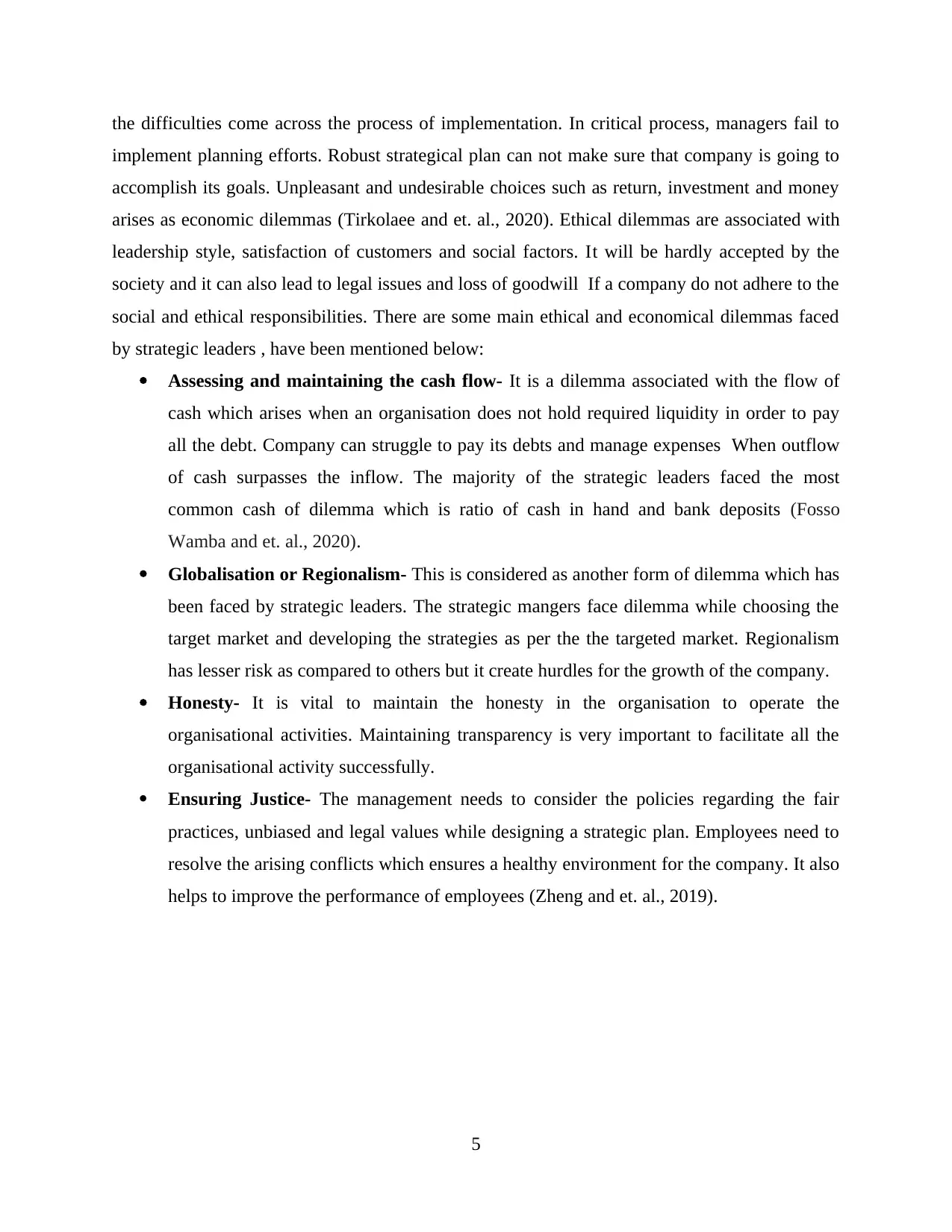
the difficulties come across the process of implementation. In critical process, managers fail to
implement planning efforts. Robust strategical plan can not make sure that company is going to
accomplish its goals. Unpleasant and undesirable choices such as return, investment and money
arises as economic dilemmas (Tirkolaee and et. al., 2020). Ethical dilemmas are associated with
leadership style, satisfaction of customers and social factors. It will be hardly accepted by the
society and it can also lead to legal issues and loss of goodwill If a company do not adhere to the
social and ethical responsibilities. There are some main ethical and economical dilemmas faced
by strategic leaders , have been mentioned below:
Assessing and maintaining the cash flow- It is a dilemma associated with the flow of
cash which arises when an organisation does not hold required liquidity in order to pay
all the debt. Company can struggle to pay its debts and manage expenses When outflow
of cash surpasses the inflow. The majority of the strategic leaders faced the most
common cash of dilemma which is ratio of cash in hand and bank deposits (Fosso
Wamba and et. al., 2020).
Globalisation or Regionalism- This is considered as another form of dilemma which has
been faced by strategic leaders. The strategic mangers face dilemma while choosing the
target market and developing the strategies as per the the targeted market. Regionalism
has lesser risk as compared to others but it create hurdles for the growth of the company.
Honesty- It is vital to maintain the honesty in the organisation to operate the
organisational activities. Maintaining transparency is very important to facilitate all the
organisational activity successfully.
Ensuring Justice- The management needs to consider the policies regarding the fair
practices, unbiased and legal values while designing a strategic plan. Employees need to
resolve the arising conflicts which ensures a healthy environment for the company. It also
helps to improve the performance of employees (Zheng and et. al., 2019).
5
implement planning efforts. Robust strategical plan can not make sure that company is going to
accomplish its goals. Unpleasant and undesirable choices such as return, investment and money
arises as economic dilemmas (Tirkolaee and et. al., 2020). Ethical dilemmas are associated with
leadership style, satisfaction of customers and social factors. It will be hardly accepted by the
society and it can also lead to legal issues and loss of goodwill If a company do not adhere to the
social and ethical responsibilities. There are some main ethical and economical dilemmas faced
by strategic leaders , have been mentioned below:
Assessing and maintaining the cash flow- It is a dilemma associated with the flow of
cash which arises when an organisation does not hold required liquidity in order to pay
all the debt. Company can struggle to pay its debts and manage expenses When outflow
of cash surpasses the inflow. The majority of the strategic leaders faced the most
common cash of dilemma which is ratio of cash in hand and bank deposits (Fosso
Wamba and et. al., 2020).
Globalisation or Regionalism- This is considered as another form of dilemma which has
been faced by strategic leaders. The strategic mangers face dilemma while choosing the
target market and developing the strategies as per the the targeted market. Regionalism
has lesser risk as compared to others but it create hurdles for the growth of the company.
Honesty- It is vital to maintain the honesty in the organisation to operate the
organisational activities. Maintaining transparency is very important to facilitate all the
organisational activity successfully.
Ensuring Justice- The management needs to consider the policies regarding the fair
practices, unbiased and legal values while designing a strategic plan. Employees need to
resolve the arising conflicts which ensures a healthy environment for the company. It also
helps to improve the performance of employees (Zheng and et. al., 2019).
5
⊘ This is a preview!⊘
Do you want full access?
Subscribe today to unlock all pages.

Trusted by 1+ million students worldwide
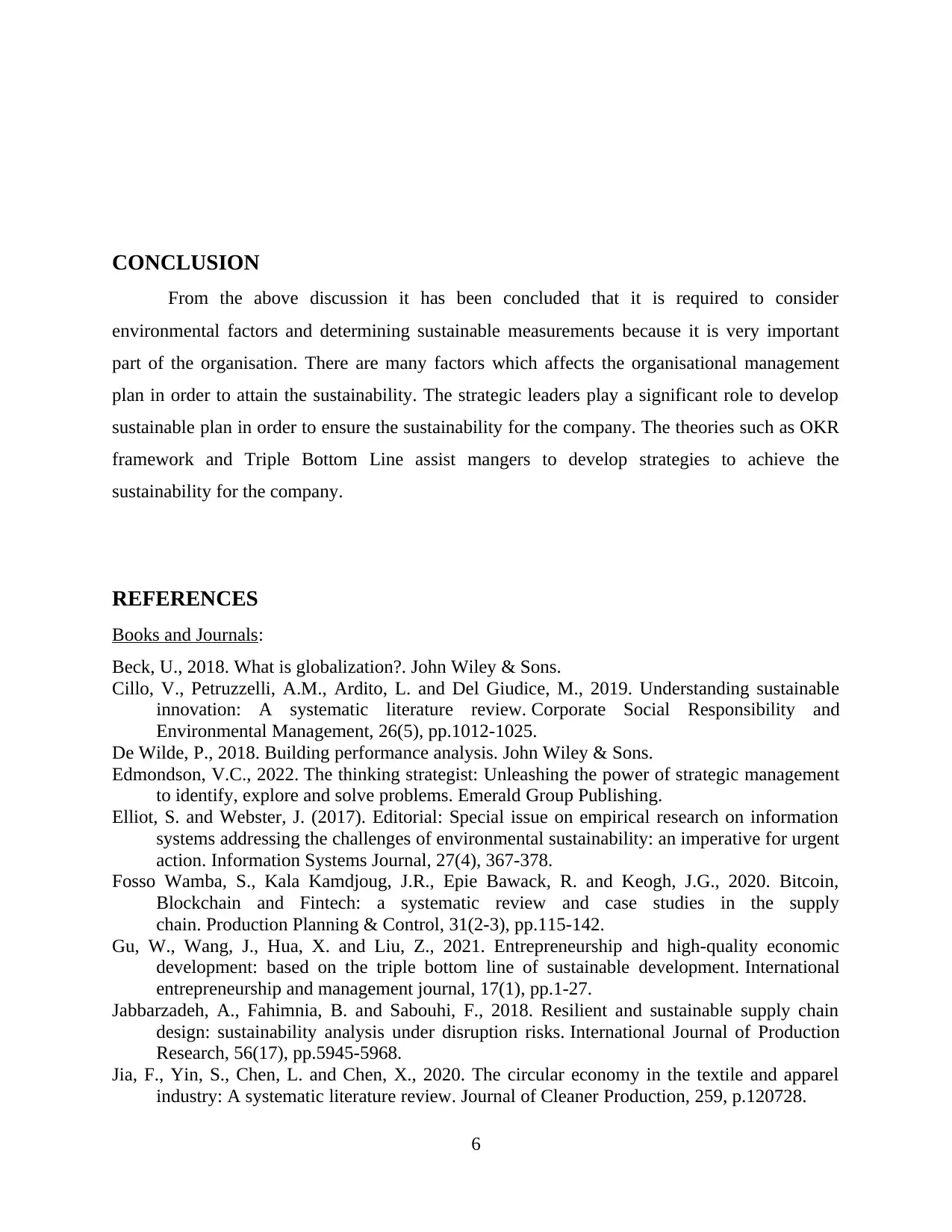
CONCLUSION
From the above discussion it has been concluded that it is required to consider
environmental factors and determining sustainable measurements because it is very important
part of the organisation. There are many factors which affects the organisational management
plan in order to attain the sustainability. The strategic leaders play a significant role to develop
sustainable plan in order to ensure the sustainability for the company. The theories such as OKR
framework and Triple Bottom Line assist mangers to develop strategies to achieve the
sustainability for the company.
REFERENCES
Books and Journals:
Beck, U., 2018. What is globalization?. John Wiley & Sons.
Cillo, V., Petruzzelli, A.M., Ardito, L. and Del Giudice, M., 2019. Understanding sustainable
innovation: A systematic literature review. Corporate Social Responsibility and
Environmental Management, 26(5), pp.1012-1025.
De Wilde, P., 2018. Building performance analysis. John Wiley & Sons.
Edmondson, V.C., 2022. The thinking strategist: Unleashing the power of strategic management
to identify, explore and solve problems. Emerald Group Publishing.
Elliot, S. and Webster, J. (2017). Editorial: Special issue on empirical research on information
systems addressing the challenges of environmental sustainability: an imperative for urgent
action. Information Systems Journal, 27(4), 367-378.
Fosso Wamba, S., Kala Kamdjoug, J.R., Epie Bawack, R. and Keogh, J.G., 2020. Bitcoin,
Blockchain and Fintech: a systematic review and case studies in the supply
chain. Production Planning & Control, 31(2-3), pp.115-142.
Gu, W., Wang, J., Hua, X. and Liu, Z., 2021. Entrepreneurship and high-quality economic
development: based on the triple bottom line of sustainable development. International
entrepreneurship and management journal, 17(1), pp.1-27.
Jabbarzadeh, A., Fahimnia, B. and Sabouhi, F., 2018. Resilient and sustainable supply chain
design: sustainability analysis under disruption risks. International Journal of Production
Research, 56(17), pp.5945-5968.
Jia, F., Yin, S., Chen, L. and Chen, X., 2020. The circular economy in the textile and apparel
industry: A systematic literature review. Journal of Cleaner Production, 259, p.120728.
6
From the above discussion it has been concluded that it is required to consider
environmental factors and determining sustainable measurements because it is very important
part of the organisation. There are many factors which affects the organisational management
plan in order to attain the sustainability. The strategic leaders play a significant role to develop
sustainable plan in order to ensure the sustainability for the company. The theories such as OKR
framework and Triple Bottom Line assist mangers to develop strategies to achieve the
sustainability for the company.
REFERENCES
Books and Journals:
Beck, U., 2018. What is globalization?. John Wiley & Sons.
Cillo, V., Petruzzelli, A.M., Ardito, L. and Del Giudice, M., 2019. Understanding sustainable
innovation: A systematic literature review. Corporate Social Responsibility and
Environmental Management, 26(5), pp.1012-1025.
De Wilde, P., 2018. Building performance analysis. John Wiley & Sons.
Edmondson, V.C., 2022. The thinking strategist: Unleashing the power of strategic management
to identify, explore and solve problems. Emerald Group Publishing.
Elliot, S. and Webster, J. (2017). Editorial: Special issue on empirical research on information
systems addressing the challenges of environmental sustainability: an imperative for urgent
action. Information Systems Journal, 27(4), 367-378.
Fosso Wamba, S., Kala Kamdjoug, J.R., Epie Bawack, R. and Keogh, J.G., 2020. Bitcoin,
Blockchain and Fintech: a systematic review and case studies in the supply
chain. Production Planning & Control, 31(2-3), pp.115-142.
Gu, W., Wang, J., Hua, X. and Liu, Z., 2021. Entrepreneurship and high-quality economic
development: based on the triple bottom line of sustainable development. International
entrepreneurship and management journal, 17(1), pp.1-27.
Jabbarzadeh, A., Fahimnia, B. and Sabouhi, F., 2018. Resilient and sustainable supply chain
design: sustainability analysis under disruption risks. International Journal of Production
Research, 56(17), pp.5945-5968.
Jia, F., Yin, S., Chen, L. and Chen, X., 2020. The circular economy in the textile and apparel
industry: A systematic literature review. Journal of Cleaner Production, 259, p.120728.
6
Paraphrase This Document
Need a fresh take? Get an instant paraphrase of this document with our AI Paraphraser
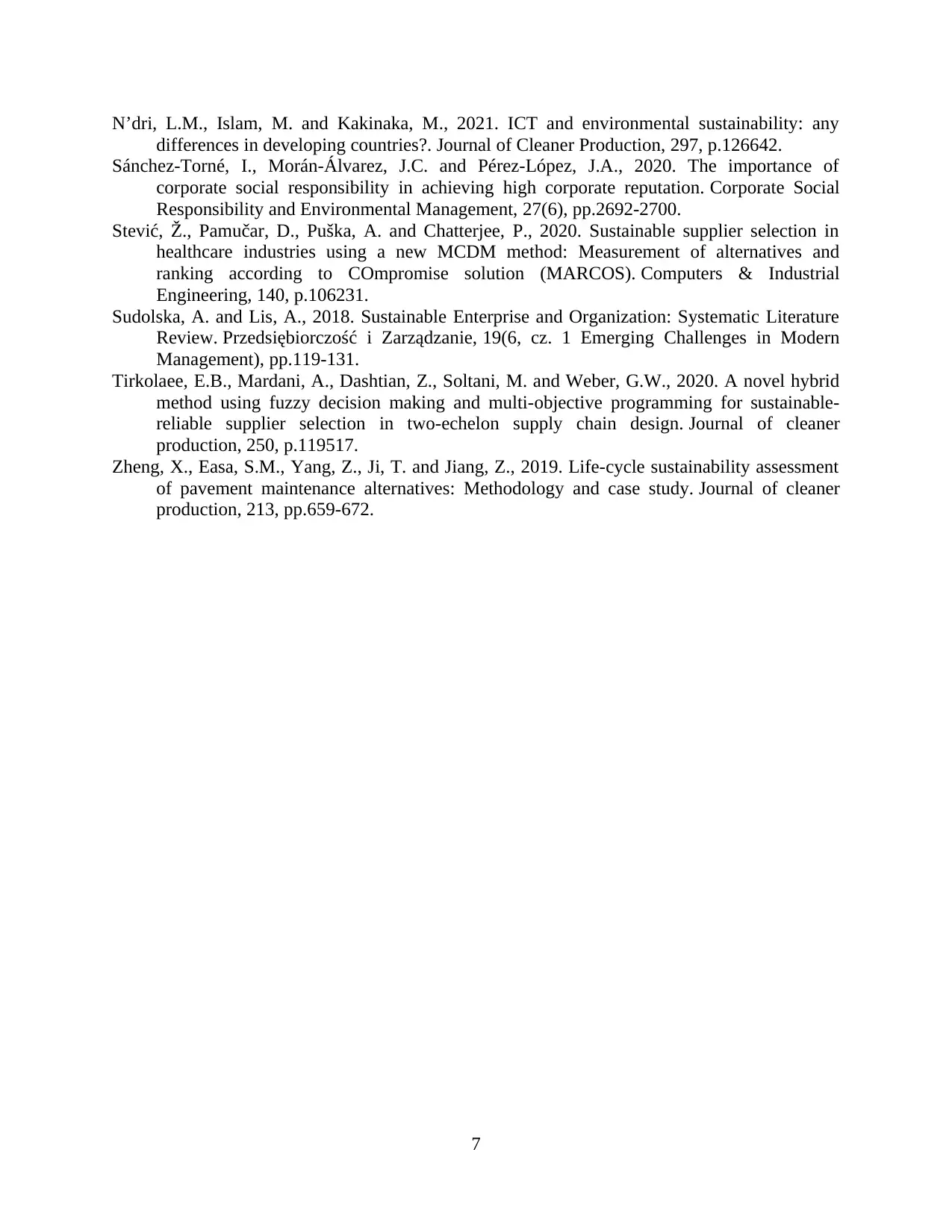
N’dri, L.M., Islam, M. and Kakinaka, M., 2021. ICT and environmental sustainability: any
differences in developing countries?. Journal of Cleaner Production, 297, p.126642.
Sánchez‐Torné, I., Morán‐Álvarez, J.C. and Pérez‐López, J.A., 2020. The importance of
corporate social responsibility in achieving high corporate reputation. Corporate Social
Responsibility and Environmental Management, 27(6), pp.2692-2700.
Stević, Ž., Pamučar, D., Puška, A. and Chatterjee, P., 2020. Sustainable supplier selection in
healthcare industries using a new MCDM method: Measurement of alternatives and
ranking according to COmpromise solution (MARCOS). Computers & Industrial
Engineering, 140, p.106231.
Sudolska, A. and Lis, A., 2018. Sustainable Enterprise and Organization: Systematic Literature
Review. Przedsiębiorczość i Zarządzanie, 19(6, cz. 1 Emerging Challenges in Modern
Management), pp.119-131.
Tirkolaee, E.B., Mardani, A., Dashtian, Z., Soltani, M. and Weber, G.W., 2020. A novel hybrid
method using fuzzy decision making and multi-objective programming for sustainable-
reliable supplier selection in two-echelon supply chain design. Journal of cleaner
production, 250, p.119517.
Zheng, X., Easa, S.M., Yang, Z., Ji, T. and Jiang, Z., 2019. Life-cycle sustainability assessment
of pavement maintenance alternatives: Methodology and case study. Journal of cleaner
production, 213, pp.659-672.
7
differences in developing countries?. Journal of Cleaner Production, 297, p.126642.
Sánchez‐Torné, I., Morán‐Álvarez, J.C. and Pérez‐López, J.A., 2020. The importance of
corporate social responsibility in achieving high corporate reputation. Corporate Social
Responsibility and Environmental Management, 27(6), pp.2692-2700.
Stević, Ž., Pamučar, D., Puška, A. and Chatterjee, P., 2020. Sustainable supplier selection in
healthcare industries using a new MCDM method: Measurement of alternatives and
ranking according to COmpromise solution (MARCOS). Computers & Industrial
Engineering, 140, p.106231.
Sudolska, A. and Lis, A., 2018. Sustainable Enterprise and Organization: Systematic Literature
Review. Przedsiębiorczość i Zarządzanie, 19(6, cz. 1 Emerging Challenges in Modern
Management), pp.119-131.
Tirkolaee, E.B., Mardani, A., Dashtian, Z., Soltani, M. and Weber, G.W., 2020. A novel hybrid
method using fuzzy decision making and multi-objective programming for sustainable-
reliable supplier selection in two-echelon supply chain design. Journal of cleaner
production, 250, p.119517.
Zheng, X., Easa, S.M., Yang, Z., Ji, T. and Jiang, Z., 2019. Life-cycle sustainability assessment
of pavement maintenance alternatives: Methodology and case study. Journal of cleaner
production, 213, pp.659-672.
7
1 out of 11
Related Documents
Your All-in-One AI-Powered Toolkit for Academic Success.
+13062052269
info@desklib.com
Available 24*7 on WhatsApp / Email
![[object Object]](/_next/static/media/star-bottom.7253800d.svg)
Unlock your academic potential
Copyright © 2020–2025 A2Z Services. All Rights Reserved. Developed and managed by ZUCOL.
